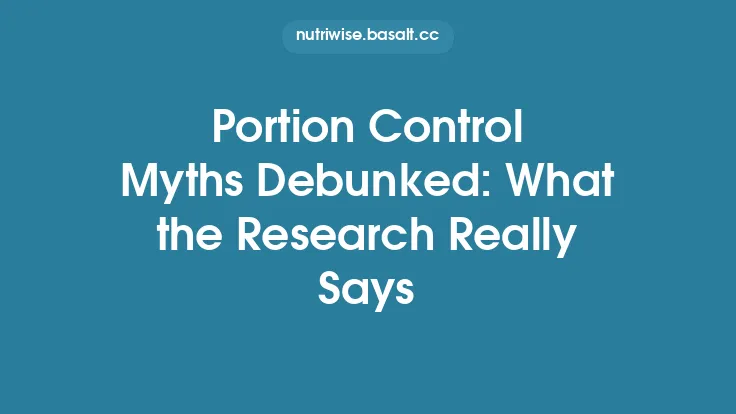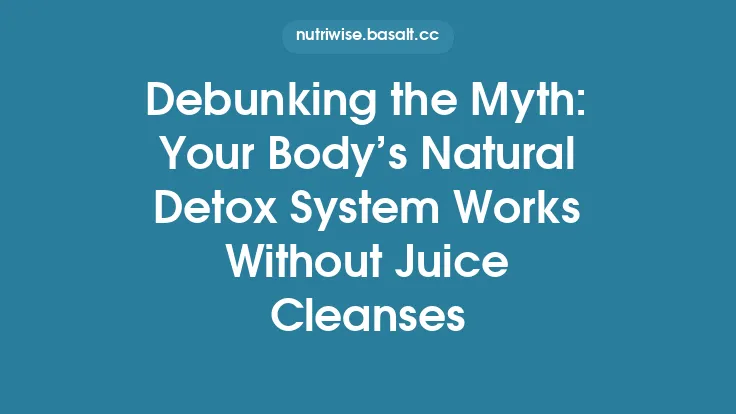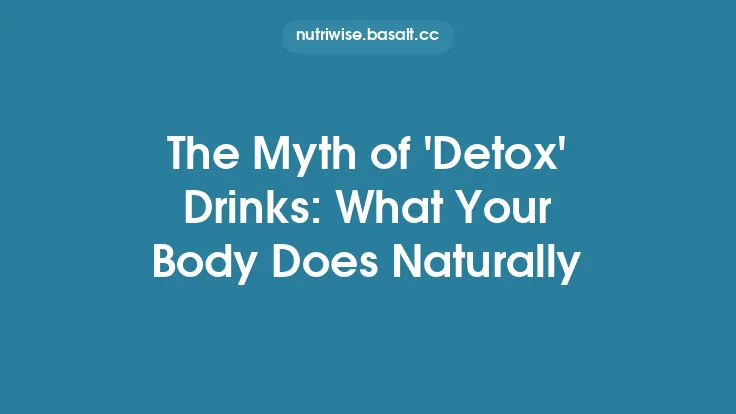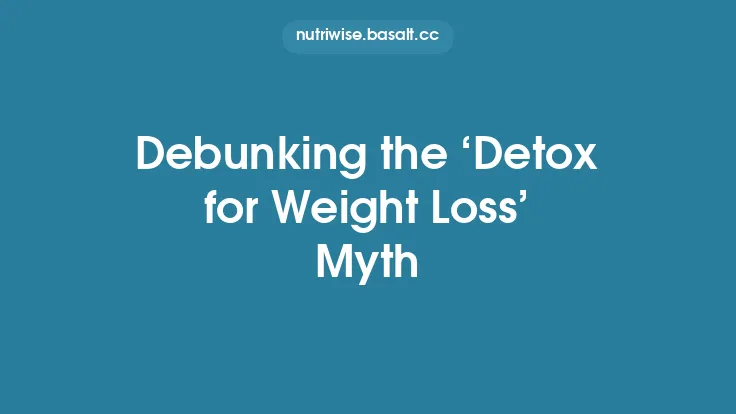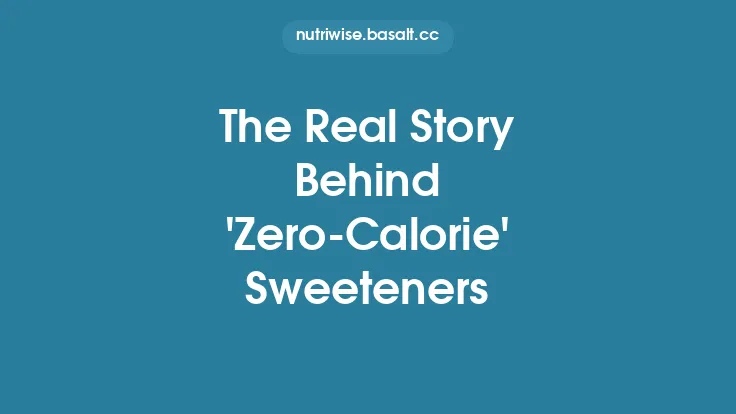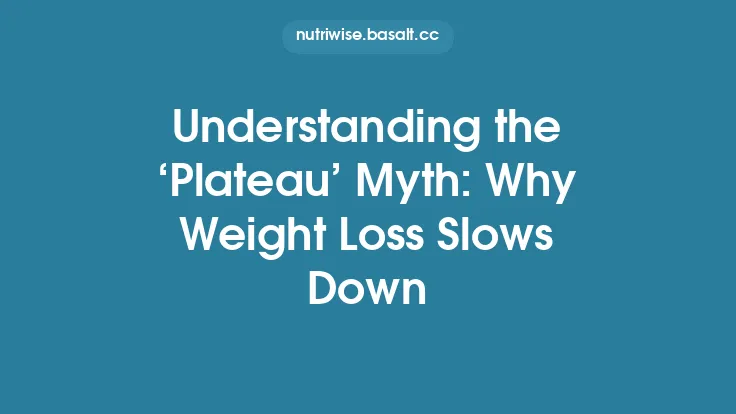When you hear the phrase “boost your metabolism,” it often conjures images of miracle teas, exotic supplements, or a single “fat‑burning” workout that will magically torch calories while you sit on the couch. The reality is far more nuanced. Metabolism—your body’s ability to convert food into energy—is a complex, tightly regulated system shaped by genetics, physiology, and everyday habits. While certain lifestyle choices can influence how many calories you burn, the notion that you can dramatically “turn up” your metabolic furnace with a quick fix is largely a myth. Understanding what truly drives calorie expenditure helps you set realistic expectations and focus on sustainable strategies for weight management.
Understanding Metabolism: The Basics
Metabolism is not a single number but a collection of processes that together determine how much energy your body uses each day. The total daily energy expenditure (TDEE) is typically broken down into three major components:
| Component | Approx. Contribution | What It Represents |
|---|---|---|
| Basal Metabolic Rate (BMR) | 60–75 % | Energy required to maintain vital functions (breathing, circulation, cellular repair) at rest. |
| Thermic Effect of Food (TEF) | 5–10 % | Energy used to digest, absorb, and process nutrients. |
| Activity‑Related Energy Expenditure (AEE) | 15–30 % | Calories burned through all forms of movement, from structured exercise to fidgeting. |
BMR is the largest and most stable component, largely dictated by lean body mass, age, sex, and genetics. AEE is the most variable and offers the greatest opportunity for intentional modification.
Key Determinants of Your Calorie Expenditure
- Lean Body Mass (Muscle, Organs, Bone)
- Muscle tissue is metabolically active, consuming roughly 13–15 kcal per kilogram per day at rest, compared to about 4–5 kcal for adipose tissue. However, the difference is modest; a 10‑kg increase in muscle might raise BMR by only 130–150 kcal/day.
- Organs such as the brain, liver, heart, and kidneys are disproportionately energy‑hungry, accounting for ~20 % of BMR despite representing <5 % of body weight.
- Genetics
- Twin and family studies estimate that 20–30 % of BMR variation is hereditary. Certain gene variants (e.g., *UCP1, FTO*) influence mitochondrial efficiency and appetite regulation, subtly affecting overall energy balance.
- Age
- BMR declines roughly 1–2 % per decade after age 20, primarily due to loss of lean mass and hormonal shifts. This natural slowdown underscores the importance of preserving muscle as you age.
- Sex
- On average, men have higher BMRs than women because they possess more lean mass and larger organ size relative to body weight.
- Hormonal Milieu
- Thyroid hormones (T3/T4) are primary regulators of basal metabolism. Hyper‑ or hypothyroidism can cause clinically significant changes in energy expenditure.
- Sex hormones (estrogen, testosterone) also modulate muscle mass and fat distribution, indirectly influencing BMR.
Common “Metabolism‑Boosting” Claims and the Science Behind Them
| Claim | Typical Product/Advice | Evidence Summary |
|---|---|---|
| Spicy foods (e.g., cayenne) dramatically raise calorie burn | Adding hot peppers or “fat‑burning” sauces | Capsaicin can increase thermogenesis by ~50 kcal/day in controlled settings, but the effect is transient and negligible in the context of total daily intake. |
| Green tea or coffee “ignites” metabolism | Consuming 2–3 cups daily, often marketed as “fat‑burning” beverages | Caffeine raises resting energy expenditure by ~3–5 % (≈30–50 kcal for a 70‑kg adult). The effect plateaus with habitual use due to tolerance. Catechins in green tea may add a modest extra 20–30 kcal, but results vary. |
| “Metabolism‑boosting” supplements (e.g., forskolin, garcinia cambogia) | Over‑the‑counter pills promising rapid weight loss | Most studies show minimal to no impact on BMR. Some ingredients may slightly increase lipolysis, but the magnitude is insufficient to affect body weight without caloric deficit. |
| Eating more frequently (e.g., 6 small meals) speeds up metabolism | Meal‑frequency plans claiming higher TEF | TEF is proportional to total caloric intake, not meal timing. Splitting calories across more meals does not increase total daily TEF and may even lead to higher overall intake for some individuals. |
| Cold exposure (ice baths, cryotherapy) supercharges calorie burn | Short, intense cold sessions marketed for “fat loss” | Cold‑induced thermogenesis can raise energy expenditure, but the increase is modest (≈50–100 kcal per hour) and requires prolonged exposure to be meaningful. Moreover, excessive cold can trigger stress responses that counteract benefits. |
The common thread is that while many of these strategies produce a measurable uptick in calorie expenditure, the absolute numbers are small—often comparable to the calories in a single slice of bread. Relying on them as primary weight‑loss tools is unrealistic.
The Role of Physical Activity Beyond the Gym
Physical activity is the most potent lever for influencing AEE, yet its impact extends beyond structured workouts:
- Exercise‑Induced Energy Expenditure (EIEE): A 60‑minute moderate‑intensity cardio session may burn 400–600 kcal, depending on intensity and body size.
- Post‑Exercise Oxygen Consumption (EPOC): High‑intensity interval training (HIIT) can elevate metabolism for 12–24 hours post‑exercise, adding roughly 5–10 % to total daily burn.
- Non‑Exercise Activity Thermogenesis (NEAT): Everyday movements—standing, walking to the printer, fidgeting—can account for 200–700 kcal/day. Small habit changes (e.g., taking stairs, using a standing desk) accumulate over weeks and months.
- Resistance Training: While cardio burns more calories during the session, resistance training builds lean mass, which modestly raises BMR over time and improves insulin sensitivity, aiding long‑term weight management.
How Body Composition Influences Energy Use
Two individuals with identical body weight can have vastly different metabolic rates if their body composition differs. For example:
- Athlete A: 70 kg, 55 % lean mass → BMR ≈ 1,650 kcal/day.
- Sedentary B: 70 kg, 40 % lean mass → BMR ≈ 1,500 kcal/day.
The 150‑kcal difference illustrates why preserving or increasing muscle through resistance training is a worthwhile strategy, even if the absolute boost is modest.
Hormonal and Age‑Related Influences
- Thyroid Function: Subclinical hypothyroidism can reduce BMR by 5–10 %. Screening and appropriate treatment can restore metabolic rate.
- Insulin Sensitivity: Chronic high insulin levels (often from excessive refined carbohydrate intake) can promote fat storage and blunt lipolysis, indirectly affecting net calorie balance.
- Menopause: Declining estrogen leads to a shift toward central adiposity and a slight BMR reduction. Strength training and adequate protein intake can mitigate these changes.
- Growth Hormone & IGF‑1: Levels decline with age, contributing to loss of lean mass. While supplementation is not recommended without medical indication, resistance training naturally stimulates their release.
Environmental and Lifestyle Factors
| Factor | Mechanism | Approximate Impact |
|---|---|---|
| Ambient Temperature | Cold environments trigger brown adipose tissue (BAT) activation; heat reduces the need for thermogenesis. | Mild cold (≈19 °C) can raise daily EE by 5–10 % in BAT‑active individuals. |
| Sleep Duration & Quality | Sleep deprivation elevates ghrelin (hunger hormone) and reduces leptin, increasing appetite; it also impairs glucose metabolism. | 1‑hour less sleep can increase daily intake by ~200 kcal and modestly lower EE. |
| Stress & Cortisol | Chronic stress promotes visceral fat accumulation and may reduce resting EE via sympathetic down‑regulation. | Effects are individual; some experience increased appetite and reduced activity. |
| Hydration | Water‑induced thermogenesis: ingesting 500 ml of cold water can raise EE by ~30 kcal for about an hour. | Small, short‑term boost; overall impact minimal. |
These variables illustrate that “metabolism” is not isolated to internal physiology; external conditions and daily habits shape it continuously.
Adaptive Thermogenesis: Why Metabolism Slows During Dieting
When caloric intake is reduced, the body initiates adaptive thermogenesis—a protective response that lowers BMR beyond what would be predicted by weight loss alone. Mechanisms include:
- Reduced Sympathetic Activity: Lower norepinephrine levels decrease resting EE.
- Hormonal Shifts: Decreases in thyroid hormones, leptin, and sex hormones blunt metabolic rate.
- Mitochondrial Efficiency: Cells become more efficient at extracting ATP, using fewer calories for the same work.
Studies show that a 10 % caloric deficit can lead to a 5–10 % drop in BMR after several weeks, making further weight loss progressively harder. This phenomenon explains why many dieters experience a “plateau” despite continued adherence to reduced‑calorie diets.
Practical Strategies for Sustainable Metabolic Health
- Prioritize Resistance Training
- Aim for 2–3 sessions per week targeting all major muscle groups. Even modest gains in lean mass can provide a lasting BMR uplift.
- Incorporate High‑Intensity Intervals
- Short bursts of vigorous effort (e.g., 30 seconds sprint, 90 seconds walk) 1–2 times weekly boost EPOC and improve cardiovascular fitness.
- Stay Active Throughout the Day
- Use a pedometer or smartphone to track steps; target 7,000–10,000 steps/day. Small NEAT enhancements compound over months.
- Optimize Sleep
- Aim for 7–9 hours of quality sleep. Consistent bedtime routines and limiting screen exposure improve hormonal balance and appetite regulation.
- Manage Stress
- Mindfulness, yoga, or brief daily relaxation techniques can lower cortisol, supporting healthier body composition.
- Maintain Adequate Protein Intake
- Consuming 1.2–1.6 g protein per kilogram body weight daily supports muscle maintenance, especially during calorie restriction, and modestly raises TEF (≈20–30 % of protein calories).
- Stay Hydrated and Consider Temperature
- Drinking water throughout the day supports metabolic processes. If comfortable, occasional exposure to mildly cool environments (e.g., brisk walks in cooler weather) can activate BAT without undue stress.
- Avoid Reliance on “Quick‑Fix” Products
- Most over‑the‑counter metabolism boosters provide negligible calorie‑burn benefits and may carry side‑effects. Focus on evidence‑based lifestyle changes instead.
Myth‑Busting Summary
- Myth: Certain foods or supplements can double your metabolism.
Fact: Most “boosters” raise resting energy expenditure by less than 5 %—a few dozen calories per day.
- Myth: Eating many small meals revs up calorie burn.
Fact: Thermic effect depends on total calories, not meal frequency; frequent meals may increase overall intake.
- Myth: You can permanently raise your BMR with a short‑term intervention.
Fact: BMR is relatively stable; lasting changes require sustained alterations in lean mass, hormonal health, and lifestyle.
- Myth: Cold exposure or “fat‑burning” workouts alone can offset a poor diet.
Fact: While they add calories burned, the magnitude is modest; diet quality remains the primary driver of energy balance.
Understanding the true levers of metabolism empowers you to make realistic, science‑backed choices. Rather than chasing fleeting “boosts,” focus on building lean muscle, staying active throughout the day, and nurturing sleep and stress‑management habits. These foundational strategies create a resilient metabolic environment that supports long‑term weight management without the need for miracle claims.
